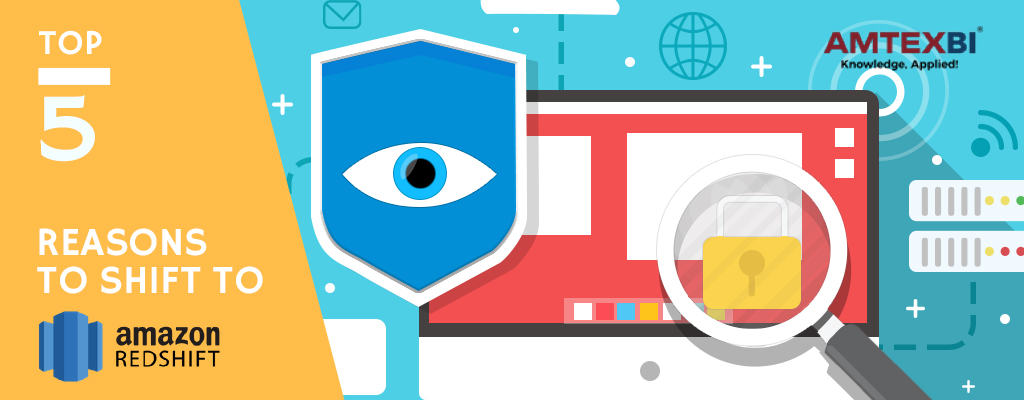AWS Redshift – 5 reasons to make the shift!
Over the past couple of months, BI nerds at Amtex have been working with Amazon’s range of cloud offerings including Redshift. At Amtex BI, we offer cloud migration services to our clients and in a tryst with Redshift, we’ve seen some features and standards that have our interests piqued!
To evaluate Redshift as an alternative to traditional Databases, we went through a full-fledged PoC and have verified first-hand, how deftly Redshift can support a BI setup. With blazing fast speeds and petabyte-scale data warehousing, Redshift seems like the ideal candidate when shifting BI Application and Data, from on-premise to Cloud.
Stay tuned for updates on the PoC Verdict – we’ll be rolling out the actual statistics in the next post, which clearly show 10x faster speeds!
Here are 5 compelling reasons to migrate to Redshift:
1. Easy to use:
Amazon’s Redshift is a simple and easy to use platform. Administrators will adapt quickly thanks to a familiar back-end that works with PostgreSQL, JDBC, and ODBC drivers. Simultaneously, Redshift makes it simple to couple with the business insight tools of your choice, for instance, Information Builders WebFOCUS is now available on the AWS Marketplace as a plug-n-play solution. Quick setup and faster time-to-production is invariably the biggest advantage here. The ease and speed of querying data in AWS Redshift is quite unlike on-premise solutions. Tasks can be managed and monitored easily in Amazon Redshift thanks to a friendly UI.
2. Scalable:
Redshift scores a big advantage over on-premise data warehousing solutions, when it comes to expanding the infrastructure or meeting increased storage demands. AWS Redshift can be scaled up or down with a few clicks and companies find that while expanding cloud infrastructure in a pay-as-you-use way, they get to be in total control of infrastructure expenses. AWS Redshift deftly handles queries right from gigabytes to exabytes, by activating individual nodes of different sizes using simple API calls or a few clicks on the AWS management console. The best part is the ability to analyze data across the user’s database without complicated and undermining ETL procedures.
3. High Performance:
The capability to query open data formats and effectively make the move from a data warehouse to a data lake is certainly 10 steps ahead in terms of performance. Independent data silos might never make the cut when compared to the business insights that Redshift Spectrum would facilitate. This unique feature helps Redshift query data across the data warehouse and data lake together, without the need for unnecessary data movement. Amazon Redshift delivers 10x faster performance and sub-second response times thanks to machine learning, parallel architecture, and compute-optimized hardware. Spend less time modeling your warehouse and more time gaining insights – the best value proposition so far!
4. Secure:
Some of you may just let out a chuckle when we discuss this. But let’s cut the myth and talk facts when it comes to data security on the cloud. Amazon Redshift has a client and server-side encryption – database encryption includes AWS Key Management Service (KMS) or AWS cloud-based Hardware Security Model (HSM) and SSL encryption for data transit when data is accessible. Amazon Redshift is compliant with SOC1, SOC2, SOC3, and PCI DSS Level 1 requirements. A VPC (virtual private network) isolates your data warehouse cluster and connects it to your existing infrastructure using industry-standard encrypted IPsec VPN. That said, statistics indicate that Redshift delivers high standards of data security that 70% organizations will not be able to afford, let alone deploy, upgrade, or maintain.
5. Low cost:
The whole deal as per their latest update costs less than $1,000/TB/YR. When launching a cluster, you can choose between Dense Compute (SSD) and Dense Storage (HDD) instance families. You can now reserve all dense storage and dense compute instances types for one year with No Upfront payment, and receive a 20% discount over On-Demand rates. For steeper discounts, you can pay for your entire reserved instance term with one All Upfront payment. Amazon Redshift is the most cost-effective cloud data warehouse solution with a cost estimation of approx. one-tenth of the traditional warehouses on premise. From costs as low as $0.25 per hour with no commitments to $250 per terabyte per annum, customers can ramp up resources in times of demand and ramp down when cost-cutting.






